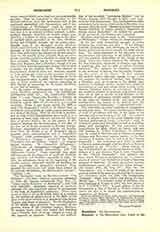

Bogomili, a Neo-Manichaean sect, found in the later Middle Ages at Constantinople and in the Balkan States. Doctrinal Principles.—The admission of a twofold creative principle, one good, the other evil, formed the basis of the doctrinal system of the Bogomili, as of all Manichean sects. Originally, they seem to have claimed eternity far these two principles, but their teaching in its fuller development was less dualistic. God the Father, according to them, had a human appearance but was incorporeal. He had two sons, the first-born, Satanael, and the younger, Jesus Christ or Michael. Satanael, though seated at the right hand of the Father and endowed with creative power, rebelled and was, with some of the angels, his followers, cast out of heaven. He created a second heaven and a second earth, and formed man out of earth and water. Being unable to give him a living spirit, he besought the Father to bestow life on this new creation, which would be their common property. God consented and thus man is the production of two creators. Eve, created in a similar manner, was seduced by Satanael. In punishment of this sin, Satanael lost his creative power, but retained sway over his own creation and strove successfully for the ruin of man. To save mankind, God sent His second son, Jesus, who penetrated the right ear of Mary and took from her the semblance of a human body; indeed, everything material in Him was merely appearance. Jesus vanquished Satanael, who lost his divine name El, and was henceforth called Satan. His place in heaven was now occupied by his conqueror. The Holy Ghost was sent forth, but dwells only in the Bogomili. Both He and Jesus will ultimately be absorbed by the Father, the only surviving person in God. The sect rejected the Old Testament, except the Psalter and the Prophetical books. Instead of baptism by water, it admitted only a spiritual baptism; it denied the Real Presence in the Eucharist, condemned marriage, rejected images, and prohibited the eating of meat.
History.—The name of the Bogomili has been traced by some to Bog Milui (God have mercy), a formula of prayer believed to have been in frequent use among them; others have sought its origin in Bogomil (beloved of God), which is also said to have been the name of a prominent representative of their doctrine in the tenth century. Other names were also applied to the members of the sect by its adversaries; but they called themselves Christians. The Bogomili probably developed from the Euchites and, although they existed previously, came into prominence in the twelfth century. They are first mentioned by name in 1115 at Philippopolis (European Turkey). More definite knowledge regarding them was obtained when their leader Basil, monk and physician, who had surrounded himself with twelve apostles, became known at Constantinople to the emperor Alexius I, Comnenus (1081-1118). The latter cleverly obtained from Basil a frank exposition of the doctrine of the sect. Having received this information, he demanded from the leader and those of his followers who could be seized a retractation of their errors. Some complied with this demand and were released; others remained obstinate and died in prison. Basil alone was condemned to death (1118) and burned. Vigorous as the repression was, it did not suppress the heresy. A synod of Constantinople (1140) ordered the destruction of writings propagating the errors of the sect; in 1143, two bishops of Cappadocia were deposed for embracing its tenets; and the favor extended to one of its adherents, the monk Niphon, caused the deposition of Cosmas, Patriarch of Constantinople (1147). The Patriarch Germanus (1221-39) continued to combat the pernicious doctrines; new condemnations were issued by the synods of Constantinople in 1316 and 1325. The Bogomili, however, remained until the conquest of the Balkan States by the Mussulmans in the fourteenth and fifteenth centuries.
N. A. WEBER

